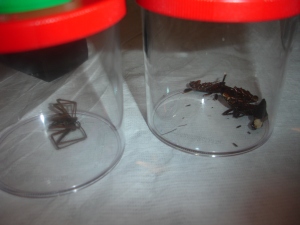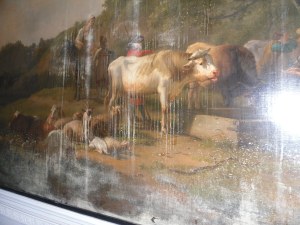Conservation Week
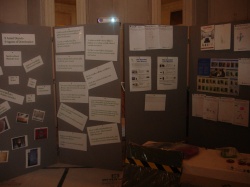
Half term saw us make use of the flood-damaged Saloon as a display space for Conservation Week, as we aimed to get children, and adults, involved in the work we do to take care of Plas Newydd. Alex, Sarah and I created various displays and activities to teach visitors about problematic pests, the 9 agents of deterioration and the equipment and techniques we use for cleaning and caring for the house and collections. I think we succeeded in making conservation fun, whilst sneakily teaching the children something too.
The pest display of course went down well; everyone loves a look at some creepy-crawlies, and once we’ve interested them with the dead bugs in pots we can explain the different sorts of damage that pests do to the collection.
We had 4 types of pests in our pots: Indian cockroaches, a moth, a spider, and webbing clothes moths. The webbing clothes moths are the smallest but the most destructive, as they create webs in textiles, then set about reproducing and eating as much of the material as they can. The spider might have caused the most people to withdraw in horror (myself included), but it is actually the least harmful; the greatest crime we can accuse spiders of is creating unsightly webs, and they are really quite useful for keeping other pests at bay. Once the kids had learned about our pests we invited them to create their own PestBot to help us out around the house and we got some brilliant creations:
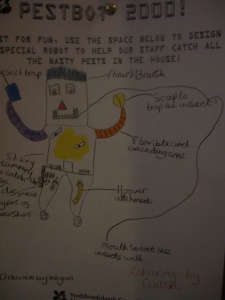
I created a game to teach our visitors about the 9 agents of deterioration, which are the 9 things that we as conservators need to be aware of and work to combat. You can have a go at the game yourself if you like (go on, humour me): Simply match the agent to the damage it does-
9 Agents of Deterioration Game
The Agents-
1. Physical Forces
2. Thieves and Vandals
3. Fire
4. Water
5. Pests
6. Light
7. Moisture (Relative Humidity)
8. Temperature
9. Contaminants
The Damage They Do-
A. I damage materials with smoke and I can destroy pretty much anything
B. I fade the colour of clothes and paintings
C. I can be a small action, like dropping a vase, or a big disaster, like an earthquake
D. We like to eat clothes and paper, and we burrow into wood to make our homes
E. I am things like dust and sweat that eat wood and metal
F. We like to steal or break valuable things
G. I make metals rust and wood swell up
H. If I am too hot photos can change colour, but if I am too cold paintings can crack
I. Too much of me and wood goes mouldy and textiles shrink, but too little of me and paintings can crack and furniture falls apart
I’ll stick the answers at the end of the blog. You may also be interested to know there is considered to be a 10th agent of deterioration, in the form of custodial neglect, which is when the person in charge of caring for a collection fails to prevent or combat the 9 agents.
Although the team at Plas Newydd do an excellent job at keeping the 9 agents at bay, we do have a prime example of water damage in the Saloon, after a burst pipe a couple of floors up flooded the room in September 2011. The Saloon has now had a year to dry out and so we are beginning to put it back together again, with work starting in Conservation Week. We had expert conservator Alan Bush in working on our water damaged Paul Ommeganck painting and so providing another example of conservation in action for our visitors. The water damage was mainly confined to the varnish on the painting, so Alan is removing the varnish, touching up the pigment on the painting where it is damaged, and then re-varnishing it.
As if this wasn’t enough exciting conservation action, we also had demonstrations about the cleaning of the collections, with a chance for visitors to give it a go themselves. On Monday Alex was showing visitors, and me, the way we polish and wax metal.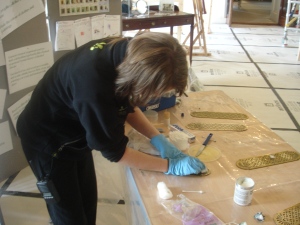
We used the brass door-plates from the bedrooms for visitors to polish. First you apply and remove Peek polish and then apply and remove Renaissance Wax. Once polished metals do look shiny and nice, but this isn’t really why we do it. When we polish we actually remove a layer of metal and so we need to be selective about when we polish and be careful not to overdo it. We polish to remove dirt and dust, which allow rust and mould to grow on metal. Over-polishing can cause metals to lose their patina, which is their surface layer; if you over-polish brass it will lose its patina and look like copper. It is also worth noting that we only polish certain metals; for example, we wouldn’t polish lacquered metals. We explained all of this to our visitors, and although they listened, they still seemed determined to get our door-plates as shiny as possible and we did appreciate their enthusiasm!
Finally, we had a box full of our cleaning equipment out for kids to rummage through. I was amazed by how interested children were in our different types of brushes, from pony hair brushes for fine gilt to long and tough radiator brushes. We also had a hardhat, high-vis’ vest and nilfisk hoover out for people to try on:
Lots of children, perhaps foolishly, enjoyed themselves so much they promised to help out with the cleaning at home. And I think we could have recruited a few new conservation workers, had they been a few years older; apparently there are laws against child labour…
On that note, I’ll say goodbye. Sorry for the long blog, but Conservation Week deserved a good write-up.
Chloe x
Answers to the 9 Agents Game: 1) C, 2) F, 3) A, 4) G, 5) D, 6) B, 7) I, 8) H, 9) E
